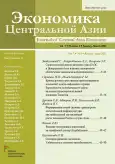Scenarios of economic development of Uzbekistan in conditions of instability
- Authors: Kurpayanidi K.I.1
-
Affiliations:
- Fergana Polytechnic Institute
- Issue: Vol 7, No 1 (2023)
- Pages: 63-80
- Section: Articles
- URL: https://journals.rcsi.science/2542-0607/article/view/146578
- DOI: https://doi.org/10.18334/asia.7.1.117188
- ID: 146578
Cite item
Abstract
About the authors
Konstantin Ivanovich Kurpayanidi
Fergana Polytechnic Institute
Email: antinari@gmail.com
профессор кафедры «Экономика», кандидат экономических наук, доцент
References
- Курпаяниди К.И., Толибов И. Современные состояние и приоритетные направления дальнейшего развития экономики узбекистана в условиях глобализации // Theoretical applied science. – 2017. – № 10(54). – c. 176-185. – doi: 10.15863/TAS.2017.10.54.29.
- 2023 yil va 2024-2025 yillar davri uchun pul-kredit siyosatining asosiy yo´nalishlari. Toshkent: Markaziy bank. - 2022
- Gómez A., Dopazo C., Fueyo N. The future of energy in Uzbekistan // Energy. – 2018. – p. 329-338. – doi: 10.1016/j.energy.2015.03.073.
- Kurpayanidi K. National innovation system as a key factor in the sustainable development of the economy of Uzbekistan // 2021 ural environmental science forum on sustainable development of industrial region: E3S Web of Conferences. Chelyabinsk, 2021. – p. 5026.– doi: /10.1051/e3sconf/202125805026.
- Popov V. Can Uzbekistan Economy Retain Its High Growth Rate? Scenarios of Economic Development in 2015-30 // Scenarios of Economic Development. – 2015.
- Abdullaev A. Covid-19 pandemic in central Asia: policy and environmental implications and responses for SMES support in Uzbekistan // E3S Web of Conferences: Vol. 258. EDP Sciences. 2021.– doi: 10.1051/e3sconf/202125805027.
- Impact of social media, Extended Parallel Process Model (EPPM) on the intention to stay at home during the COVID-19 pandemic // Sustainability. – 2022. – № 12. – p. 7192. – doi: 10.3390/su14127192.
- Kok K., Pedde S., Gramberger M., Harrison P.A., Holman I.P. New European socio-economic scenarios for climate change research: operationalising concepts to extend the shared socio-economic pathways // Regional Environmental Change. – 2019. – № 3. – p. 643-654. – doi: 10.1007/s10113-018-1400-0.
- Loizou Efstratios et al. The role of agriculture as a development tool for a regional economy // Agricultural Systems. – 2019. – № 173. – p. 482-490.
- Wang Jia et al. Dynamic assessment of tourism carrying capacity and its impacts on tourism economic growth in urban tourism destinations in China // Journal of Destination Marketing and Management. – 2020. – p. 100383. – doi: 10.1016/j.jdmm.2019.100383.
- Crawford Megan M., George Wright The value of mass-produced COVID-19 scenarios: A quality evaluation of development processes and scenario content // Technological Forecasting and Social Change. – 2022. – p. 121937. – doi: 10.1016/j.techfore.2022.121937.
- Kurpayanidi K., Abdullaev A., Ashurov M., Tukhtasinova M., Shakirova Y. The issue of a competitive national innovative system formation in Uzbekistan // 1st international conference on business technology for a sustainable environmental system: 1st International Conference on Business Technology for a Sustainable Environmental System, BTSES 2020. Том 159. Almaty, 2020. – p. 04024.– doi: 10.1051/e3sconf/202015904024.
- Pogosov I. A. Factors of long-term economic growth: Scientific and technical progress and capital intensity of production // Studies on Russian Economic Development. – 2015. – № 5. – p. 423-433. – doi: 10.1134/S1075700715050135.
- Wang Qian, Shenggang Ren, Ya Hou Atmospheric environmental regulation and industrial total factor productivity: the mediating effect of capital intensity // Environmental Science and Pollution Research. – 2020. – № 26. – p. 33112-33126. – doi: 10.1007/s11356-020-09523-4.
- Litvinenko V.S. Digital economy as a factor in the technological development of the mineral sector // Natural Resources Research. – 2020. – № 3. – p. 1521-1541. – doi: 10.1007/s11053-019-09568-4.
- Razzaq Asif et al. Dynamic and causality interrelationships from municipal solid waste recycling to economic growth, carbon emissions and energy efficiency using a novel bootstrapping autoregressive distributed lag // Resources, Conservation and Recycling. – 2021. – p. 105372.
Supplementary files








